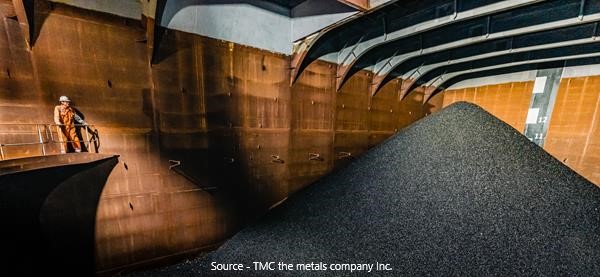The Future and the Present of deep seabed mining
February 2, 2023
It seems that the time has come for me to cover the future potential of deep seabed mining as there are only 6 months left until the deadline will expire which was just recently (almost two years ago) invoked by the Republic of Nauru. Please check my previous Blog post about the Republic of Nauru and the two years deadline click here.
1. What is happening right now? Is everything ready for the beginning of exploitation phase of deep seabed mining?
2. What will happen after the deadline?
Point one.
Many things and processes are taking place as I write this Blog post. Let's start with the most important one - the development of the necessary legal framework by the International Seabed Authority, later I will mention some interesting developments from the rest of the world.
International Seabed Authority (ISA)
The ISA is an institution responsible for the management of deep seabed and its resources. As you read this post the ISA is developing the necessary legal framework so the exploitation of deep seabed could start and should start very soon as the Republic of Nauru requested.
Development of the necessary legal framework for the exploitation a.k.a. the regulations on exploitation (and supporting documents) started around ten years ago. However, the work is not done yet, the final version is nowhere to be seen.
We have plenty of draft regulations on exploitation. As the whole creation process is taking around a decade we have more than one draft version. The last consolidated draft of regulations on exploitation were published in 2019 and still is the main one as the ISA keeps this version the front of its website. It is quite obvious that drafts do not have much significance but they can help you to paint a general picture or basic direction of where we are going, nevertheless, a newer version than 2019 is not available.
Instead on the ISA's website, you can find a lot of documents, presentations, suggestions, comments and other material regarding the negotiation and development of the regulations on exploitation. This demonstrates the complexity of the issue and additionally how it difficult is to find common ground. To have a better understanding of the work of working groups here.

The chance to follow the development of the legal framework would allow us to scrutinize the work of ISA and to see whether they are maintaining the quality or are too lenient in favor of the swiftness of the decision.
All in all, regarding the current status of the regulations on exploitation, there are way too many questions and aspects still to cover that it seems not possible to expect the completion of the regulations on exploitation in the next 6 months.
The rest of the World
We have many players and actors who are well engaged in the whole upcoming deep seabed mining epopee. Honorable mentions go to state parties, contractors, scientists, activists, NGOs, etc. That being said I intend to mention only a few recent and noticeable events that in my opinion have shaken the development of deep seabed mining.
- The number one is the president of France who said that deep seabed mining should be stopped, not postponed but simply stopped. France is not the first country that opposed deep seabed mining but others have taken a bit more lenient approach. Will it have a significant impact on deep seabed mining development? It might, it might not. What is clear is that the Council has to reach a consensus to adopt the regulations on exploitation and France is one of the members. N.B. there is a new resolution by the French Parliament but it should be covered in a separate Blog post.
- The number two is a deep seabed mining testing that took place in the second half of 2022. The deep seabed mining test was conducted by one of the frontrunners of deep seabed mining - the Metals company (TMC), more precisely by its subsidiaries. Moreover, it is not the first deep seabed mining test and not the last one, nevertheless what makes it quite significant is the fact that around 4 500 tons of polymetallic nodules were mined (image below).

UPDATE. While I was writing this Blog post some good/bad news came in. First, the activists/scientists shared a video from the famous TMC testing (paragraph above). In the video, there were images of the discharge of sediments from the mining vessel directly to the ocean (while it should have been discharged deep underwater).
The Public and investors were unaware of the accident not until the NGOs shared the videos here.
The problem is not the accident itself, but the lack of communication with the public which damages the credibility of the TMC. No one would expect that all testing would be fully successful or there are no risks and everything will be perfect. Nevertheless, communication is the key. You need to communicate about all the risks while not pretending that everything went perfectly when it did not.
What to expect from the TMC? Should we hope that the next time another scientist will have a phone with him and manage to capture another accident, otherwise no one will know about it? Neither the general public nor investors who are sponsoring their activities?
To sum up, deep seabed mining is going to its start at alarming speed with a lack of communication. It seems that the ISA intends to push deep seabed mining into exploitation while the rest of the world has not concentrated enough power to stop it or push it back.
Point two.
As it was explained before, the ISA is developing the regulations on exploitation and while the situation indicates that it cannot be completed within the next 6 months I believe the ISA intends to do it, well at least produce the final version of regulations to the Council for its consideration. It should not be forgotten that next to the regulations on exploitation there are supposed to be various supporting documents (standards, guidelines) and they are also being developed as their significance is lower and the development is less challenging. It could be assumed that the necessary legal framework is only on the way and it does not look like it can be ready by the end of the deadline.
However, even with the necessary legal framework missing after the deadline the entities can apply for approval of a plan of work for exploitation and the Council shall consider and provisionally approve such plans (The Agreement Section 1 paragraph 15 (b)).
At this point, it seems that the first entity that would submit such an application will be TMC. Nevertheless, the TMC company faces many difficulties and challenges in its endeavor to concur deep seabed.
Disclaimer - the provided content below is not financial advice, it is for informational purposes only.
Since the TMC went public its stock went whooping 90-95% down leaving its initial investor with a significant loss. In addition to that, the stock exchange informed TMC that it might be removed from the stock exchange by June if the stock will not trade higher than 1$ for 10 consecutive days. Furthermore, TMC's cash balance shows it has left around 66 million dollars while it spends around 30 million each quarter which means it has probably enough cash only until the end of summer.
All in all, there is a good chance that the TMC will not make it to the deadline and will crumble earlier. In addition to the current issues there will be a huge need for additional funds even after receiving the necessary permit, thus there will be a need for a significant investment until TMC will be profitable.
TMC has enough money to last until the end of the summer and it is right after the deadline for ISA (although ISA has not adopted the regulations on exploitation yet) to be obliged to consider the application by TMC. This whole process will give positive momentum to the stock and its price will rise and new investors (or those who already spent millions) will rise the stack. Finally, after the consideration, the application will be eventually approved.
In my opinion, considering the existing legal framework, the most certain way to postpone the rash beginning of exploitation is a chance that TMC will burn its cash faster than its application will be approved. Otherwise, neither the ISA nor the TMC have any interest to postpone the beginning of deep seabed mining until more scientific knowledge will be available or at least does not show any signs of this intention.
